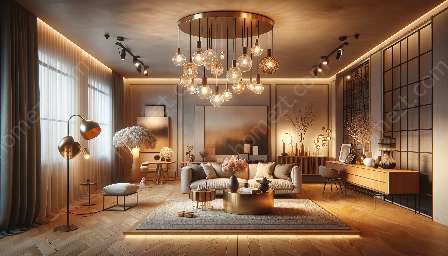When it comes to enhancing the ambiance and functionality of your living spaces, lighting plays a crucial role. Recessed lighting, also known as can lights or downlights, is a versatile choice for achieving a modern, sleek look while providing ample illumination. This comprehensive guide will explore the intricacies of recessed lighting installation, its compatibility with various lighting fixtures and installation methods, and how it contributes to homemaking and interior decor.
Understanding Recessed Lighting
Before delving into the installation process, it's essential to grasp the basics of recessed lighting. Unlike traditional fixtures that protrude from the ceiling, recessed lights are installed flush with the surface, creating a streamlined and unobtrusive look. These fixtures consist of three main components:
- Housing: The housing is the main body of the fixture that's installed within the ceiling structure. It holds the electrical components and provides support for the trim and bulb.
- Trim: The trim is the visible part of the fixture and comes in various styles such as baffle, reflector, and adjustable. It helps direct and control the light, as well as adds an aesthetic touch to the space.
- Bulb: Recessed lights accommodate different types of bulbs, including incandescent, LED, and halogen, allowing for customization based on the desired ambiance and energy efficiency.
Installation Process
Installing recessed lighting involves several crucial steps to ensure safety, proper functionality, and aesthetic appeal.
1. Planning and Design
Prior to installation, careful planning is essential. Factors such as the ceiling type, desired lighting layout, and the location of electrical wiring must be considered. A well-thought-out design ensures that the lighting serves its purpose effectively and harmonizes with the overall decor.
2. Electrical Wiring
For new installations, electrical wiring needs to be routed from the power source to the locations of the recessed lights. This step requires knowledge of electrical codes and safety practices to prevent hazards.
3. Cutting Openings
Once the wiring is in place, openings are cut in the ceiling to accommodate the housing of the recessed lights. Care must be taken to ensure precise measurements and alignment for a clean, professional appearance.
4. Installing Housing
The housing is then secured into the ceiling, with careful attention to insulation and any obstructions such as pipes or ductwork. Proper anchoring ensures the stability and longevity of the fixtures.
5. Adding Trim and Bulbs
Finally, the trim is installed, and the bulbs are inserted into the housings. Adjustments can be made to customize the direction and intensity of the light to suit the specific requirements of the space.
Compatibility with Lighting Fixtures and Installation
Recessed lighting harmonizes seamlessly with a wide range of lighting fixtures and installation approaches, adding versatility to interior lighting design.
1. Complementary Fixtures
While recessed lighting is often used as the primary source of ambient lighting, it can be combined with pendant lights, chandeliers, and wall sconces to create layered lighting effects. This combination adds depth and visual interest to the room, catering to various functional and aesthetic needs.
2. Integrating Controls
Modern recessed lighting systems can be integrated with dimmer switches, smart controls, and home automation systems, allowing for convenient adjustment of lighting levels and creating different moods for different occasions.
3. Energy-Efficient Solutions
When paired with energy-efficient bulbs such as LED or CFL, recessed lighting contributes to sustainable living by reducing energy consumption and minimizing environmental impact. It aligns with the trend of eco-friendly and cost-effective lighting solutions.
Homemaking and Interior Decor Enhancement
Besides its functional aspects, recessed lighting significantly contributes to homemaking and interior decor, elevating the visual appeal and livability of the home.
1. Space Optimization
By integrating recessed lighting into the ceilings, valuable floor and wall space are freed up, allowing for more flexibility in furniture arrangement and showcasing architectural features without obstruction.
2. Visual Impact
The unobtrusive nature of recessed lighting creates a clean and contemporary aesthetic, making it an ideal choice for modern and minimalist interior designs. It complements various decor styles without overpowering other decorative elements.
3. Ambient Enhancement
Recessed lighting provides even illumination throughout the room, reducing glare and shadows. This creates a welcoming and comfortable atmosphere, conducive to relaxation, social gatherings, and everyday activities.
4. Property Value
When designed and installed with precision, recessed lighting adds a touch of sophistication and luxury to the home, potentially increasing its resale value. Prospective buyers often appreciate well-executed lighting solutions as a desirable feature of a property.
Conclusion
With its versatility, functionality, and aesthetic appeal, recessed lighting stands as a foundational element in modern interior illumination. Its seamless integration with various fixtures, compatibility with advanced controls, and significant impact on homemaking and interior decor make it a top choice for homeowners and designers alike. By understanding the nuances of recessed lighting installation and its holistic benefits, you can transform your living spaces into inviting, well-lit sanctuaries that reflect your personal style and elevate the overall ambiance.


